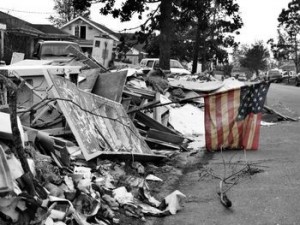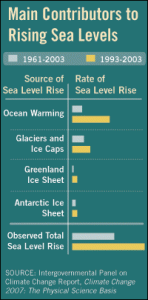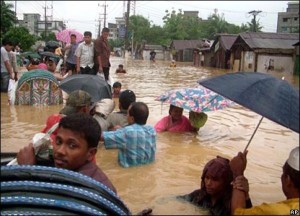
Aftermath of Hurricane Katrina
With climate change comes more intense floods and droughts in designated areas as well as uncertainties regarding the frequency, severity, and location of future hurricanes. But to say that these uncertainties (or contradictions) shouldn’t provoke precautionary measures or major adaptations is like dismissing the devastating impacts of Hurricane Katrina altogether. The fact of the matter is nearly two thousand people lost their lives due to the harshness of this storm and the United States’ inadequate preparation/response. These natural disasters will certainly persist and intensify as the Earth’s temperature increases causing oceans to warm, expand, and rise. The question is…will we be ready?

The major contributors to the rising sea-level is the expansion of water as the ocean absorbs heat from the atmosphere and melts water from glaciers and ice caps.
Densely populated, low-lying coastal regions are prone to the highest risk of hurricanes and flooding. But it is not just coastal areas that are threatened. Extreme precipitation events lead to more intense and frequent river flooding causing damage to infrastructure and real estate, problems with water quality and availability, and weakened economies. In several rivers across west and parts of eastern Europe, the return period of what is currently a 100-year flood may in the future decrease to 50 years or less.
In the United States, the National Flood Insurance Program has been criticized for offering policies that encourage people to build homes in flood-prone areas. However, FEMA has recently undertaken efforts to measure the impact of climate change on flood insurance which should result in raising policy premiums and forcing flood lines to be redrawn to include more homes. The question then becomes: how effective will this and similar policies be (that is, if they are even developed) in dissuading development in environmentally unstable areas? History has not lent me much confidence regarding this issue.

Miami skyscrapers and development along the coast. This is essentially the status quo, or model, for beach cities around the world.
And what about the many cities that already exist in dangerous areas? The Organization for Economic Cooperation and Development lists 10 cities face the highest risk from flooding right now due to their geographic placement: Mumbai, Guangzhou, Shanghai, Miami, Ho Chi Minh City, greater New York City, Calcutta, Osaka-Kibe, Alexandria and New Orleans. Additionally, ten percent of the world’s population lives within 10 m of sea level. Areas like Bangladesh are even worst off as nearly 50% of the population live within this echelon. Clearly, these cities need to develop and implement infrastructure for protection. But where will the funding come from? Poor countries often have the most difficult times adjusting to increased environmental threats as they lack the resources to build protection for their cities are unable to mobilize and move in the face of danger.

Flood in Bangladesh
If we were completely aware of the dangers of climate change before developing these major cities the answer would be clear—don’t do it! But these are the homes for millions and millions of people; it would be unreasonable and unfeasible to think they can just leave. So will stricter building codes, planning regulations and insurance laws be the answer? Although they must play a larger and more responsible role in the future, my guess is no. The only clear answer must address the heart of the problem. We have to stabilize GHG concentrations in the atmosphere at a level that would prevent dangerous anthropogenic interference with the climate system.
Tags: climate change, Drought, floods, hurricanes, sustainable development